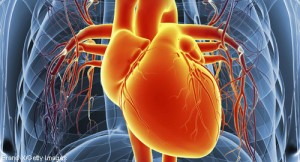 ACR CONVERGENCE 2020—Patients with idiopathic inflammatory myopathies, including polymyositis (PM), dermatomyositis (DM), inclusion body myositis and juvenile DM, experience inflammation of skeletal muscles that leads to muscle weakness. Although clinically significant heart involvement is uncommon in these patients, recent studies show an increased prevalence of traditional cardiovascular risk factors associated with both juvenile and adult DM and PM. Example: The risk of developing atherosclerotic coronary artery disease is increased two- to fourfold in patients with DM or PM.1,2
ACR CONVERGENCE 2020—Patients with idiopathic inflammatory myopathies, including polymyositis (PM), dermatomyositis (DM), inclusion body myositis and juvenile DM, experience inflammation of skeletal muscles that leads to muscle weakness. Although clinically significant heart involvement is uncommon in these patients, recent studies show an increased prevalence of traditional cardiovascular risk factors associated with both juvenile and adult DM and PM. Example: The risk of developing atherosclerotic coronary artery disease is increased two- to fourfold in patients with DM or PM.1,2
In the ACR Convergence 2020 session titled, Myositis: Getting to the Heart, Louise P. Diederichsen, MD, PhD, discussed emerging methods for diagnosing myocarditis and identified myositis-related autoantibodies that may be associated with myocarditis and cardiomyopathy in idiopathic inflammatory myopathies.
Sammy Zakaria, MD, MPH, a cardiologist with an interest in the cardiac manifestations of rheumatic disease, then shared his perspective on the management of cardiac myositis, which included traditional risk factors, when to refer to a cardiologist and a suggested patient evaluation.
Autoantibodies & the Heart in Myositis
Dr. Diederichsen, an associate professor and consultant at Copenhagen University Hospital, Rigshospitalet, Denmark, is conducting research on how myositis affects the cardiovascular system. She began her presentation by describing two key mechanisms of heart disease in myositis: accelerated atherosclerosis of the coronary arteries and inflammation of the myocardium (i.e., myocarditis).
Atherosclerosis caused by a plaque comprising fat, calcium and cholesterol can be identified using coronary angiography and cardiac computed tomography (CT) scan. A large body of evidence indicates the risk of coronary artery disease is increased in patients with myositis.
A 2015 study conducted by Dr. Diederichsen and colleagues investigated coronary artery disease in myositis patients. This cross-sectional study included 76 patients with PM/DM and 48 healthy controls, and coronary artery calcification was measured using CT scan. Researchers found high calcification in patients with PM/DM, at a rate of 20% compared with 4% in healthy controls. They also noted some myositis patients had several comorbidities, including obesity, hypertension and diabetes.3
Moving on to discuss diagnosis, Dr. Diederichsen noted myocarditis can be identified through endomyocardial biopsy, which is considered the gold standard. The disease can also be identified with cardiac magnetic resonance imaging (MRI), which can identify morphological abnormalities, such as tissue characterization of the pericardium and myocardium, as well as functional abnormalities, such as left ventricular ejection fraction.
Dr. Diederichsen next defined two different types of cardiac MRI used to identify myocardial inflammation and fibrosis: conventional cardiac MRI, with gadolinium-enhanced T1-weighted images used to see fibrosis; and T2-weighted images used to see edema and inflammation. New and developing cardiac MRI mapping techniques quantify myocardial relaxation times, T1 mapping/extracellular volume quantifies diffuse myocardial inflammation and fibrosis, and T2 mapping quantifies myocardial edema and inflammation.
For the prevalence of myocarditis in myositis, which is largely unknown, Dr. Diederichsen said non-controlled case series using traditional cardiac MRI criteria have found changes consistent with subclinical myocarditis in 56–75% of myositis patients.4 In a similar study using T1 mapping in 25 PM/DM patients without cardiovascular symptoms, compared with 25 healthy controls, myocardial fibrosis was identified in 19% of PM/DM patients.5
“This indicates T1 mapping of cardiac MRI [may] be a valuable tool to detect subclinical myocardial involvement in asymptomatic myositis patients,” she said.
Further, although cardiac MRI cannot distinguish between different myocardial diseases by their magnetic properties alone, adding skeletal muscle measurements may help differentiate the conditions, as demonstrated by past research. A study from Huber et al. found MRI changes in the pectoralis muscle differentiated patients with idiopathic inflammatory myopathies from patients with acute viral myocarditis and healthy controls.6 In addition to detection, Dr. Diederichsen highlighted a 2020 study by Xu et al. suggesting T1 and T2 mapping of cardiac MRI may be valuable in monitoring subclinical myocardial involvement in myositis.7
In discussing recent studies on severe myocarditis in myositis patients, which are rare, Dr. Diederichsen said, “It’s quite striking that there is a lack of uniformity regarding subsets of myositis. These cases present various subsets of myositis with different autoantibody profiling.”
She next discussed the different autoantibodies that have been identified in patients with myositis and cardiac involvement, including myositis-specific autoantibodies, such as anti-signal recognition particle autoantibodies, and myositis-associated autoantibodies, such as anti-mitochondrial antibodies.
‘T1 mapping of cardiac MRI [may] be a valuable tool to detect subclinical myocardial involvement in asymptomatic myositis patients.’ —Louise P. Diederichsen, MD, PhD
Looking toward further research in this area, Dr. Diederichsen mentioned several unmet needs, including prospective cardiovascular studies on larger cohorts of myositis patients to identify cardiac biomarkers in myositis and international standardized cardiovascular screening recommendations for myositis.
Cardiologist’s Perspective
Dr. Zakaria, an associate professor of medicine at the Johns Hopkins University School of Medicine, Baltimore, who specializes in cardiac intensive care, discussed his experiences and treatment approaches for patients with cardiac manifestations of rheumatic disease.
He began by introducing the cardiologist’s general approach to evaluating heart involvement in patients with immune-mediated disease, as described in a position statement of the European Society of Cardiology Working Group on Myocardial and Pericardial Disease.8
Dr. Zakaria said a cardiologist’s diagnostic approach for identifying myocarditis begins with two questions: Does this patient with myositis have associated myocarditis or myopericarditis? Does the patient have clinical evidence of organ damage, such as heart failure or arrhythmias?
When looking for historical clues, the cardiologist wants to see if the patient has any evidence of unexplained dyspnea, which may indicate heart failure; palpitations or syncope, which may indicate the patient has had arrythmias; and chest pain, which may be a sign of heart failure, myopericarditis or accelerated coronary artery disease.
“We have to remember that patients with autoimmune myositis actually have higher rates of macrovascular and microvascular coronary artery disease,” he said.
The next diagnostic approach is a physical examination for heart failure, which looks for important signs, such as a third heart sound, abdominojugular reflux, jugular venous distension or rales.9
Next, a cardiologist will order a battery of tests, including laboratory studies and imaging. Lab tests include—but are not limited to—a blood draw to identify elevated levels of troponin and disease-related biomarkers. However, Dr. Zakaria noted, myocarditis can be found in patients with and without myositis-related antibodies.
Imaging studies can include electrocardiogram, in which 85% of patients with myocarditis show an abnormality, and echocardiogram, in which 65% of myocarditis patients show abnormality. Cardiac MRI is the best way to evaluate myocarditis non-invasively, he said, citing a study by Sharma et al.10
“Patients with myocarditis have a characteristic pattern of myocardial involvement. It tends to occur in the subepicardial or mid-myocardial regions, which are different [from] what you see in patients with coronary artery disease,” Dr. Zakaria said.
Cardiac computed tomography has the added benefit of evaluating the coronary artery to look for obstructive disease.
Endomyocardial biopsy is still the gold standard to diagnose myocarditis and guide changes in disease management. However, it’s an invasive procedure with adverse events. Dr. Zakaria said, “I tend to consider it if a patient has clear evidence of non-ischemic heart failure and we need to confirm a diagnosis of myocarditis.”
After myocarditis is diagnosed, Dr. Zakaria works closely with the referring rheumatologist to plan care management. “When I’m thinking of treating a patient’s myocarditis, it’s hard for me to do that in isolation from rheumatologic treatments, because myocardial involvement is secondary to the underlying myositis,” he said.
In this case, he tends to follow the lead of the rheumatologist, because the patient is often on multiple immunosuppressants and immunomodulators. One caveat to this approach is if the patient has severe decompensation in cardiac status, which usually indicates the need for more intensive therapy. Dr. Zakaria also looks for side effects of therapies, such as complications to the heart from high doses of steroids.
Regarding cardiac-specific therapies, Dr. Zakaria clarified that no specific studies have tested these therapies in patients with autoimmune myopathies. If the patient has evidence of heart failure, his first-line treatment is diuretic therapy. If there is evidence of obstructive coronary artery disease, he refers patients for potential intervention.
After this, he considers therapies to treat heart failure, including angiotensin-converting enzyme (ACE) inhibitors or angiotensin receptor blocker (ARB) therapy.11 A beta blocker may also be prescribed to support favorable cardiac remodeling in a stable patient. Dr. Zakaria also recommended aldosterone antagonist therapy. If these therapies are ineffective, he moves to advanced therapy, including the consideration of ventricular assist devices, heart transplant or, more likely, palliative care.
Dr. Zakaria reiterated the value of diagnostics in identifying the extent of cardiac involvement when a patient with myositis is referred to a cardiologist. After the disease state and effects are understood, he stressed how close collaboration with the patient’s rheumatologist is critical to establishing therapies proven to increase cardiac function.
Carina Stanton is a freelance science journalist based in Denver.
References
- Diederichsen LP. Cardiovascular involvement in myositis. Curr Opin Rheumatol. 2017 Nov;29(6):598–603.
- Schwartz T, Diederichsen LP, Lundberg IE, et al. Cardiac involvement in adult and juvenile idiopathic inflammatory myopathies. RMD Open. 2016 Sep 27;2(2):e000291.
- Diederichsen LP, Diederichsen AC, Simonsen JA, et al. Traditional cardiovascular risk factors and coronary artery calcification in adults with polymyositis and dermatomyositis: A Danish multi-center study. Arthritis Care Res (Hoboken). 2015 May;67(6):848–854.
- Rosenbohm A, Buckert D, Gerischer N, et al. Early diagnosis of cardiac involvement in idiopathic inflammatory myopathy by cardiac magnetic resonance tomography. J Neurol. 2015;262(4):949–956.
- Huber AT, Bravetti M, Lamy J, et al. Non-invasive differentiation of idiopathic inflammatory myopathy with cardiac involvement from acute viral myocarditis using cardiovascular magnetic resonance imaging T1 and T2 mapping.J Cardiovasc Magn Reson. 2018 Feb 12;20:11.
- Xu, Y., Sun, J., Wan, K.et al. Multiparametric cardiovascular magnetic resonance characteristics and dynamic changes in myocardial and skeletal muscles in idiopathic inflammatory cardiomyopathy. J Cardiovasc Magn Reson. 2020 Apr 9;
- Caforio ALP, Adler Y, Agostini C, et al. Diagnosis and management of myocardial involvement in systemic immune-mediated diseases: A position statement of the European Society of Cardiology Working Group on Myocardial and Pericardial Disease. Eur Heart J. 2017 Sep 14;38(35):2649–2662.
- Wang CS, FitzGerald JM, Schulzer M, et al. Does this dyspneic patient in the emergency department have congestive heart failure? JAMA. 2005 Oct 19;294(15):1944–1956.
- Sharma K, Orbai AM, Desai D, et al. Brief report: Antisynthetase syndrome-associated myocarditis. J Card Fail. 2014 Dec;20(12):939–945.
- Yancy CW, Jessup M, Bozkurt B, et al. 2017 ACC/AHA/HFSA focused update of the 2013 ACCF/AHA Guideline for the Management of Heart Failure: A report of the American College of Cardiology/American Heart Association task force on Clinical Practice Guidelines and the Heart Failure Society of America. J Am Coll Cardiol. 2017 Aug 8;70(6):776–803.



